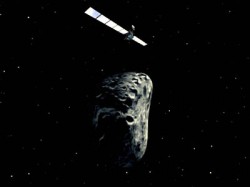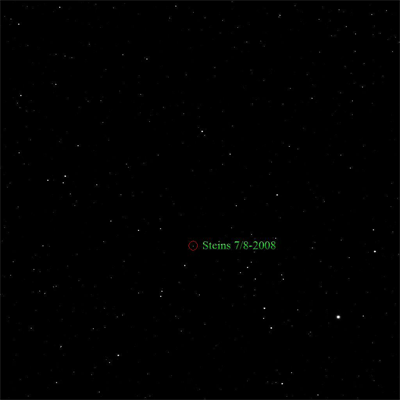[/caption]
ESA’s Rosetta spacecraft will make an historic encounter with asteroid (2867) Steins on September 5, 2008 at 20:58 CEST (Central European Summer Time), 2:58 pm EDT (US Eastern Daylight Time.) A few days ago, Rosetta conducted a successful trajectory correction maneuver using images from the spacecraft’s cameras to calculate the asteroid’s location, to optimize its trajectory for the fly-by. Rosetta will rendezvous with the asteroid while one its way to its primary mission, to visit comet 67/P Churyumov-Gerasimenko. At its closest approach to the asteroid, the spacecraft will be just 800 km from Steins.
At closest approach, however, the spacecraft will not be in communication with Earth. First ground contact with the spacecraft to verify a successful flyby will occur about an hour and half after the encounter. The first images and results will be available for presentation to the media during a press conference on Saturday, September 6 at 12:00 CEST.

Click here for an animation of Rosetta’s flyby.
Steins is Rosetta’s first nominal scientific target. The study of asteroids is extremely important as they represent a sample of Solar System material at different stages of evolution – key to understanding the origin of our own planet and of our planetary neighborhood. Rosetta will also encounter (21) Lutetia on June 10, 2010.
We’ll post the images and information from the flyby here on Universe Today as soon as they are available.
Source: ESA


These are the type of (relatively) cheap bang-for-the-buck missions we need to expand upon which actually increase our scientfic knowledge, instead of dead-end megabuck human missions to our moon and Mars – which are nothing more than the “bold vision” of a disgraced, illiterate president.
Who is the disgraced illiterate President you are referring to, Richard Nixon?
He was not illiterate, and made a significant impact on world history.
If you are referring to our present President, you better keep in mind, if not for his support for the space program, you wouldn’t be able to reply to this article.
Out of curiosity, there is an object almost directly below Steins in the 11/8-2008 that is not there (or much dimmer) in the 7/8-2008 image, even though most of the other background objects seem to be dimmer in the 11/8-2008 image.
Is this just normal variation, or something more interesting?
Markus Demetrius: if our species does not colonize and exploit our Solar System and Beyond, we will eventually go extinct–unless you want intelligent robotic spacecraft or WALL-E to succeed us.
First: No other president has given NASA a larger budget, and at no other time has NASA had more missions going on and/or in the works. As for what missions are being worked, cannot be directly pushed on to the president; make your opinion to the brass at NASA.
Second: We haven’t hardly done anything with the moon, other than just go there and come back. There are many things we don’t know and can learn from lunar missions.
Recommend you open your mind a bit more, and learn things for yourself, instead of listen to other people who seem to hold grudges for individuals.
With the first question being: What have you done for the space program, other than ignorantly critique it?
“Out of curiosity, there is an object almost directly below Steins in the 11/8-2008 that is not there (or much dimmer) in the 7/8-2008 image, even though most of the other background objects seem to be dimmer in the 11/8-2008 image.
Is this just normal variation, or something more interesting?”
I noticed that too, only it doesn’t disappear – it seems to overlap another bright point just below it…..anyone else noticed?
BME and Vic,
Note that the distance that the point travels from the overlapping at 7/8-2008 to where it shows up at 11/8-2008 is about the same distance that the Steins asteroid travels in that same time period. Only that they move in different directions. Any sky-watchers can tell us if this a variation?
ESA will blog the flyby starting 1 September. Access via: http://webservices.esa.int/blog/blog/5/